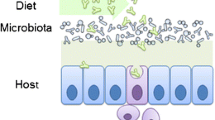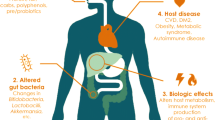Abstract
In their intestine, humans possess an “extended genome” of millions of microbial genes—the microbiome. Because this complex symbiosis influences host metabolism, physiology, and gene expression, it has been proposed that humans are complex biologic “superorganisms.” Advances in microbiologic analysis and systems biology are now beginning to implicate the gut microbiome in the etiology of localized intestinal diseases such as the irritable bowel syndrome, inflammatory bowel disease, and colon cancer. These approaches also suggest possible links between the gut and previously unassociated systemic conditions such as type 2 diabetes and obesity. The elucidation of the intestinal microbiome is therefore likely to underpin future disease prevention strategies, personalized health care regimens, and the development of novel therapeutic interventions. This review summarizes the research that is defining our understanding of the intestinal microbiome and highlights future areas of research in gastroenterology and human health in which the intestinal microbiome will play a significant role.
Similar content being viewed by others
References and Recommended Reading
Lederberg J: Infectious history. Science 2000, 288:287–293.
Dethlefsen L, McFall-Ngai M, Relman DA: An ecological and evolutionary perspective on human-microbe mutualism and disease. Nature 2007, 449:811–818.
Loscalzo J, Kohane I, Barabasi AL: Human disease classification in the postgenomic era: a complex systems approach to human pathobiology. Mol Syst Biol 2007, 3:124.
Nicholson JK, Holmes E: Global systems biology and personalized healthcare solutions. Discov Med 2006, 6:63–70.
Nicholson JK, Holmes E, Wilson ID. Gut microorganisms, mammalian metabolism and personalized health care. Nat Rev Microbiol 2005, 3:431–438.
Turnbaugh PJ, Ley RE, Hamady M, et al.: The human microbiome project. Nature 2007, 449:804–810.
Kassinen A, Krogius-Kurikka L, Makivuokko H, et al.: The fecal microbiota of irritable bowel syndrome patients differs significantly from that of healthy subjects. Gastroenterology 2007, 133:24–33.
Marchesi JR, Holmes E, Khan F, et al.: Rapid and noninvasive metabonomic characterization of inflammatory bowel disease. J Proteome Res 2007, 6:546–551.
Huycke MM, Gaskins HR: Commensal bacteria, redox stress, and colorectal cancer: mechanisms and models. Exp Biol Med (Maywood) 2004, 229:586–597.
Gill SR, Pop M, Deboy RT, et al.: Metagenomic analysis of the human distal gut microbiome. Science 2006, 312:1355–1359.
Jia W, Li H, Zhao L, Nicholson JK: Gut microbiota: a potential new territory for drug targeting. Nat Rev Drug Discov 2008, 7:123–129.
Hopkins MJ, Macfarlane GT: Changes in predominant bacterial populations in human faeces with age and with Clostridium difficile infection. J Med Microbiol 2002, 51:448–454.
Eckburg PB, Bik EM, Bernstein CN, et al.: Diversity of the human intestinal microbial flora. Science 2005, 308:1635–1638.
Martin FP, Dumas ME, Wang Y, et al.: A top-down systems biology view of microbiome-mammalian metabolic interactions in a mouse model. Mol Syst Biol 2007, 3:112.
Macpherson AJ, Geuking MB, McCoy KD: Immune responses that adapt the intestinal mucosa to commensal intestinal bacteria. Immunology 2005, 115:153–162.
Bai AP, Ouyang Q, Xiao XR, Li SF: Probiotics modulate inflammatory cytokine secretion from inflamed mucosa in active ulcerative colitis. Int J Clin Pract 2006, 60:284–288.
Hayashi H, Sakamoto M, Benno Y: Phylogenetic analysis of the human gut microbiota using 16S rDNA clone libraries and strictly anaerobic culture-based methods. Microbiol Immunol 2002, 46:535–548.
Nicholson JK, Lindon JC, Holmes E: ’Metabonomics’: understanding the metabolic responses of living systems to pathophysiological stimuli via multivariate statistical analysis of biological NMR spectroscopic data. Xenobiotica 1999, 29:1181–1189.
Nicholson JK, Connelly J, Lindon JC, Holmes E: Metabonomics: a platform for studying drug toxicity and gene function. Nat Rev Drug Discov 2002, 1:153–161.
Li M, Wang B, Zhang M, et al.: Symbiotic gut microbes modulate human metabolic phenotypes. Proc Natl Acad Sci U S A 2008, 105:2117–2122.
Strober W, Fuss I, Mannon P: The fundamental basis of inflammatory bowel disease. J Clin Invest 2007, 117:514–521.
Hampe J, Cuthbert A, Croucher PJ, et al.: Association between insertion mutation in NOD2 gene and Crohn’s disease in German and British populations. Lancet 2001, 357:1925–1928.
Swidsinski A, Ladhoff A, Pernthaler A, et al.: Mucosal flora in inflammatory bowel disease. Gastroenterology 2002, 122:44–54.
Hughes R, Cross AJ, Pollock JR, Bingham S: Dose-dependent effect of dietary meat on endogenous colonic N-nitrosation. Carcinogenesis 2001, 22:199–202.
Horie H, Kanazawa K, Okada M, et al.: Effects of intestinal bacteria on the development of colonic neoplasm: an experimental study. Eur J Cancer Prev 1999, 8:237–245.
O’Mahony L, Feeney M, O’Halloran S, et al.: Probiotic impact on microbial flora, inflammation and tumour development in IL-10 knockout mice. Aliment Pharmacol Ther 2001, 15:1219–1225.
Moore WE, Moore LH: Intestinal floras of populations that have a high risk of colon cancer. Appl Environ Microbiol 1995, 61:3202–3207.
Pimentel M, Park S, Mirocha J, et al.: The effect of a nonabsorbed oral antibiotic (rifaximin) on the symptoms of the irritable bowel syndrome: a randomized trial. Ann Intern Med 2006, 145:557–563.
Maukonen J, Satokari R, Matto J, et al.: Prevalence and temporal stability of selected clostridial groups in irritable bowel syndrome in relation to predominant faecal bacteria. J Med Microbiol 2006, 55:625–633.
Spiller RC: Role of infection in irritable bowel syndrome. J Gastroenterol 2007, 42(Suppl 17):41–47.
Kalia N, Hardcastle J, Keating C, et al.: Intestinal secretory and absorptive function in Trichinella spiralis mouse model of postinfective gut dysfunction: role of bile acids. Gut 2008, 57:41–49.
Ogden CL, Carroll MD, Curtin LR, et al.: Prevalence of overweight and obesity in the United States, 1999–2004. JAMA 2006, 295:1549–1555.
Mai V: Dietary modification of the intestinal microbiota. Nutr Rev 2004, 62:235–242.
Xu J, Bjursell MK, Himrod J, et al.: A genomic view of the human-Bacteroides thetaiotaomicron symbiosis. Science 2003, 299:2074–2076.
Narushima S, Itoha K, Miyamoto Y, et al.: Deoxycholic acid formation in gnotobiotic mice associated with human intestinal bacteria. Lipids 2006, 41:835–843.
Ley RE, Backhed F, Turnbaugh P, et al.: Obesity alters gut microbial ecology. Proc Natl Acad Sci U S A 2005, 102:11070–11705.
Turnbaugh PJ, Ley RE, Mahowald MA, et al.: An obesity-associated gut microbiome with increased capacity for energy harvest. Nature 2006, 444:1027–1031.
Backhed F, Manchester JK, Semenkovich CF, Gordon JI: Mechanisms underlying the resistance to diet-induced obesity in germ-free mice. Proc Natl Acad Sci U S A 2007, 104:979–984.
Ley RE, Turnbaugh PJ, Klein S, Gordon JI: Microbial ecology: human gut microbes associated with obesity. Nature 2006, 444:1022–1023.
Kelly D, Campbell JI, King TP, et al.: Commensal anaerobic gut bacteria attenuate inflammation by regulating nuclear-cytoplasmic shuttling of PPAR-gamma and RelA. Nat Immunol 2004, 5:104–112.
Backhed F, Ding H, Wang T, et al.: The gut microbiota as an environmental factor that regulates fat storage. Proc Natl Acad Sci U S A 2004, 101:15718–15723.
Dumas ME, Barton RH, Toye A, et al.: Metabolic profiling reveals a contribution of gut microbiota to fatty liver phenotype in insulin-resistant mice. Proc Natl Acad Sci U S A 2006, 103:12511–12516.
Fearnside JF, Dumas ME, Rothwell AR, et al.: Phylometabonomic patterns of adaptation to high fat diet feeding in inbred mice. PLoS ONE 2008, 3:e1668.
Fetissov SO, Hamze Sinno M, Coeffier M, et al.: Auto-antibodies against appetite-regulating peptide hormones and neuropeptides: putative modulation by gut microflora. Nutrition 2008, 24:348–359.
Stamler J, Elliott P, Dennis B, et al.: INTERMAP: background, aims, design, methods, and descriptive statistics (nondietary). J Hum Hypertens 2003, 17:591–608.
Holmes E, Loo RL, Stamler J, et al.: Human metabolic phenotype diversity and its association with diet and blood pressure. Nature 2008, 453:396–400.
Bengmark S: Bioecologic control of the gastrointestinal tract: the role of flora and supplemented probiotics and synbiotics. Gastroenterol Clin North Am 2005, 34:413–436, viii.
Gibson GR, Roberfroid MB: Dietary modulation of the human colonic microbiota: introducing the concept of prebiotics. J Nutr 1995, 125:1401–1412.
Lim M, Sagar P, Finan P, et al.: Dysbiosis and pouchitis. Br J Surg 2006, 93:1325–1334.
Pang X, Hua X, Yang Q, et al.: Inter-species transplantation of gut microbiota from human to pigs. ISME J 2007, 1:156–162.
Author information
Authors and Affiliations
Corresponding author
Rights and permissions
About this article
Cite this article
Kinross, J.M., von Roon, A.C., Holmes, E. et al. The human gut microbiome: Implications for future health care. Curr Gastroenterol Rep 10, 396–403 (2008). https://doi.org/10.1007/s11894-008-0075-y
Published:
Issue Date:
DOI: https://doi.org/10.1007/s11894-008-0075-y




